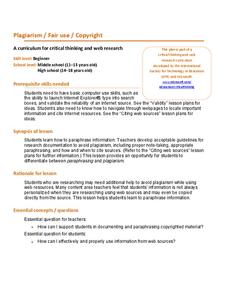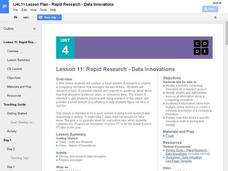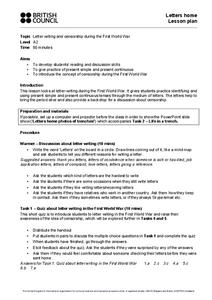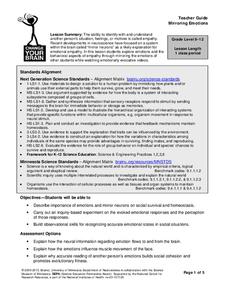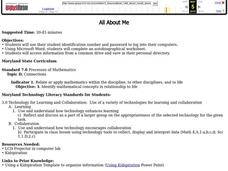Curated OER
Creating My Personal Animal ABC Book
Students conduct Internet research on various animals. They write and create an Animal ABC book, including pictures of each animal, and each animal's phyla and class, to present to a young child.
Code.org
The Cost of "Free"
Explore the trade-offs of using a free app. The fourth installment of a 12-part unit helps young consumers discover the cost of receiving a free service. They learn how these apps make use of their access to data.
Code.org
Bytes and File Sizes
A bite of bits. The first instructional activity in a unit of 15 introduces the class to the byte. Pupils learn about other standard units for measuring file sizes, develop an understanding of relative sizes and the kind of units...
Kenan Fellows
Installing and Working with R Statistical Software
Save download time—install software now in preparation for future lessons. The R statistical software is a free program used by the Federal Reserve Bank and many companies. Bring the power of the software to your classroom to use in the...
Scholastic
The First Thanksgiving Feast for Grades 6–8
It's time for the feast! Young historians complete their study of the First Thanksgiving by completing an online activity, watching a slideshow, and examining a First Thanksgiving timeline. After answering text-dependent questions to...
Code.org
The Need for Programming Languages
LEGO see if you can recreate my design. Individuals build an arrangement from LEGO blocks and write directions for someone else to follow in order to recreate the arrangement. Pairs then swap directions and try to...
Code.org
One-way Functions – The WiFi Hotspot Problem
Pupils attempt to solve the Wireless Hotspot Problem and learn why it is considered a computationally hard problem in the ninth lesson of the series on 12. They also learn about one-way functions and how the Wireless Hotspot Problem is...
Microsoft
Plagiarism Fair Use Copyright
Nothing makes junior high and high school teachers more frustrated than plagiarism. Instruct young writers about copyright laws and the correct ways to paragraph information without copying the exact words. A set of secondary-level...
Code.org
APIs and Using Functions with Parameters
Introduce your class to the API, a reference guide that lists and explains the functionality of programming language. Using JavaScript, individuals draw complex designs that require additional commands and parameters defined in the...
Code.org
Rapid Research – Data Innovations
Scholars conduct research into a computing innovation of their choice and figure out how it uses data. They prepare brief reports of their research in the second installment of the series.
Code.org
Check Your Assumptions
Always check your assumptions when interpreting data and data visualizations. That's the take away from this exercise. Class members examine a failed project that looks at search trends to predict flu outbreaks and consider the...
British Council
Letters Home
When you're writing historical fiction, the past really can become the present — especially if you're writing in the present continuous tense! Cover World War I, verb tenses, censorship, and letter writing with one informative lesson and...
Nemours KidsHealth
Water Safety: Grades 9-12
Make a big splash with a lesson about water safety. After reading three articles related to water safety, high schoolers first choose one water safety rule to research and write a report summarizing their findings. They then use an...
Nemours KidsHealth
Bike Safety: Grades 6-8
Two activities teach tweens and teens about bike safety. After reading articles about bike safety, class members design tags with important safety reminders that can be attached to bikes. Groups then create a dance video that...
Curated OER
Meet Our Teachers
Learners of all ages interview, record, and photograph teachers and staff at their school. They organize the photo with a soundbite into a PowerPoint presentation. They transcribe the interview and write a response to it.
Alabama Learning Exchange
Swim the Open Sea: Analyzing Duel Vectors
This dual vector lesson has the class watch a video about a person's swim of the English Channel. The class then uses a computer program to analyze dual vectors of wind's effect on a flight path of a plane as compared to the water...
Curated OER
I Heard It 'Round the Internet: Sexual Health Education and Authenticating Online Information
Students evaluate websites regarding sexual health information. In this media awareness lesson, students discuss facts and myths regarding sex as they determine how to find reputable online and print resources.
Curated OER
Producing Beats
Turn your classroom into a music studio as groups work together to determine why music sounds different when performed live versus a recording. After listening to some different music, each group picks a poem, creates a recording, and...
University of Minnesota
Mirroring Emotions
Do you ever give your class the "teacher look"? Without saying a word, they become silent and engaged (hopefully). How do they know what you're thinking? Explore the concept of nonverbal communication and how it relates to our...
Cornell University
Forensic Science: Case of the Missing Diamond Maker
Someone stole a diamond-making machine. Who done it? Scholars use forensic science at six different stations to determine the culprit. They analyze fingerprints, use their senses, and complete chemistry experiments to determine the...
Science 4 Inquiry
Levitation Engineers: Exploring Forces
Levitation tricks have been documented from the early 1900s, so how do they do it? Scholars learn about the force of magnetism in an attractive resource. They watch videos and design experiments to understand the strength and...
Curated OER
All About Me
Young scholars in a computer class use their student identification number and password to log into their computers. Using Microsoft Word, they complete an autobiographical worksheet/template and save the information on their own...
Curated OER
Getting To Know Famous People
First graders use the internet to research a famous American. Using the information they collect, they write a paragraph noting their accomplishments. They find a picture of the person they are researching or dress up like them to...








